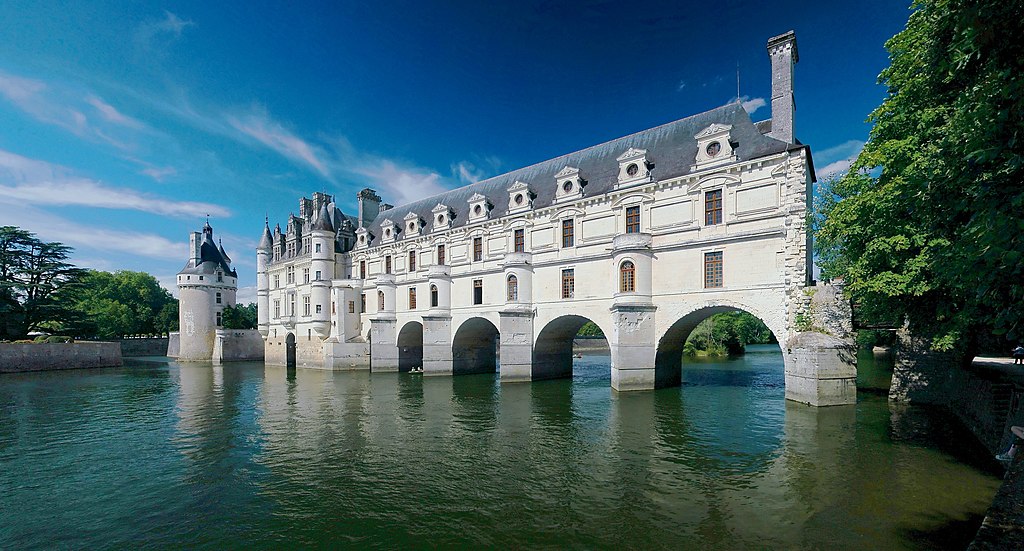Hello ladies and gents this is the viking telling you that today we are talking about

The Château de Chenonceau is a French château spanning the River Cher, near the small village of Chenonceaux in the Indre-et-Loire département of the Loire Valley in France. It is one of the best-known châteaux of the Loire valley, and it and Montsoreau are the only chateaux built over the Loire river bed.
The estate of Chenonceau is first mentioned in writing in the 11th century. The current château was built in 1514–1522 on the foundations of an old mill and was later extended to span the river. The bridge over the river was built (1556-1559) to designs by the French Renaissance architect Philibert de l'Orme, and the gallery on the bridge, built from 1570–1576 to designs by Jean Bullant
An architectural mixture of late Gothic and early Renaissance, Château de Chenonceau and its gardens are open to the public. Other than the Royal Palace of Versailles, it is the most visited château in France.
The château has been classified as a Monument historique since 1840 by the French Ministry of Culture. Today, Chenonceau is a major tourist attraction and in 2007 received around 800,000 visitors
Recent history
José-Emilio Terry, a Cuban millionaire, acquired Chenonceau from Madame Pelouze in 1891. Terry sold it in 1896 to a family member, Francisco Terry. In 1913, the château was acquired by Henri Menier, a member of the Menier family, famous for their chocolates, who still own it to this day.
During World War I Gaston Menier set up the gallery to be used as a hospital ward. During the Second World War the château was bombed by the Germans in June 1940. It was also a means of escaping from the Nazi occupied zone on one side of the River Cher to the "free" zone on the opposite bank. Occupied by the Germans, the château was bombed by the Allies on 7 June 1944, when the chapel was hit and its windows destroyed.
In 1951, the Menier family entrusted the château's restoration to Bernard Voisin, who brought the dilapidated structure and the gardens (ravaged in the Cher River flood in 1940) back to a reflection of its former glory
CHATEAU DE CHENONCEAU

The estate of Chenonceau is first mentioned in writing in the 11th century. The current château was built in 1514–1522 on the foundations of an old mill and was later extended to span the river. The bridge over the river was built (1556-1559) to designs by the French Renaissance architect Philibert de l'Orme, and the gallery on the bridge, built from 1570–1576 to designs by Jean Bullant
An architectural mixture of late Gothic and early Renaissance, Château de Chenonceau and its gardens are open to the public. Other than the Royal Palace of Versailles, it is the most visited château in France.
The château has been classified as a Monument historique since 1840 by the French Ministry of Culture. Today, Chenonceau is a major tourist attraction and in 2007 received around 800,000 visitors
Recent history
José-Emilio Terry, a Cuban millionaire, acquired Chenonceau from Madame Pelouze in 1891. Terry sold it in 1896 to a family member, Francisco Terry. In 1913, the château was acquired by Henri Menier, a member of the Menier family, famous for their chocolates, who still own it to this day.
During World War I Gaston Menier set up the gallery to be used as a hospital ward. During the Second World War the château was bombed by the Germans in June 1940. It was also a means of escaping from the Nazi occupied zone on one side of the River Cher to the "free" zone on the opposite bank. Occupied by the Germans, the château was bombed by the Allies on 7 June 1944, when the chapel was hit and its windows destroyed.
In 1951, the Menier family entrusted the château's restoration to Bernard Voisin, who brought the dilapidated structure and the gardens (ravaged in the Cher River flood in 1940) back to a reflection of its former glory
Comments
Post a Comment